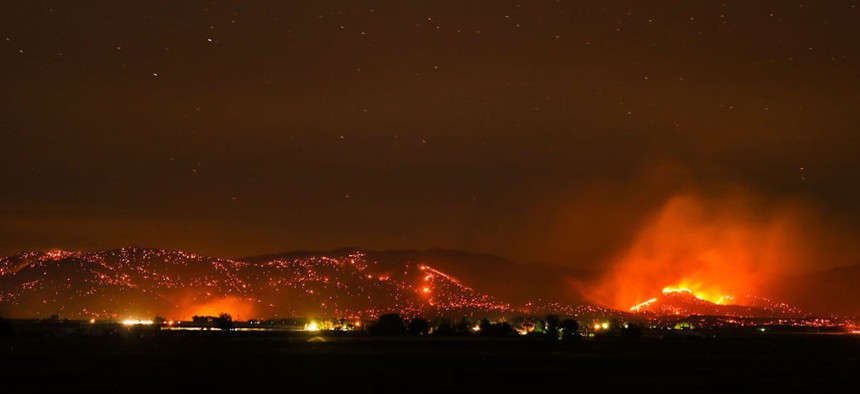AI, sensors enhance wildfire detection

A wildfire burns in sagebrush and grass on a sidehill in Warm Springs, Oregon on August 18, 2017. ROB KERR/AFP via Getty Images
A pilot program in Oregon’s Willamette Valley will test how well artificial intelligence-enabled sensors can identify and characterize wildfires, which will help with responder resource allocation and boost community resilience.
Firefighters may soon be able to detect different fire types based on chemical gas concentrations and particulate sizes using sensors and artificial intelligence algorithms currently under development.
Fifteen devices recently deployed across Oregon’s Willamette Valley will operate throughout the wildfire season under a pilot program conducted by the Department of Homeland Security’s Science and Technology Directorate, the agency said in a Feb. 9 announcement. The goal is to test the technology’s smoke detection abilities so firefighters can confirm ignition quicker, scale resources for appropriate allocation and monitor fire behavior during the containment process.
The systems will not only help responder efficiency, but as the technology advances, they could also be a part of a network of street lights, utility poles and residential doorbell camera systems, S&T’s Sensors and Platforms Technology Director Jeff Booth said in an email. In the future, they “could become part of a home alerting service, or insurance plans, or deployed on government/private vehicles for package delivery or emergency services providing a mobile detection service,” he said.
The devices were developed by companies Breeze Technologies and N5 Sensors and installed in partnership with the University of Oregon’s Oregon Hazards Lab.
To monitor and track fires, the pilot also features internet-connected, machine learning-enabled cameras provided by the ALERTWildfire program, a consortium of the University of Nevada, Reno, University of California San Diego and the University of Oregon. Firefighters and first responders can assess landscape conditions, fire behavior and weather in real-time and time-lapse imagery using the cameras. ALERTWildfire also provides public-facing video feeds that could facilitate faster evacuations, according to the announcement.
Using a cell signal, the smoke detectors will upload data to the cloud where firefighters are alerted of fire events via dashboards. Data gathered during the pilot will be used to “refine the AI to help avoid false positives, improve detection times, while also determining distance between sensors to help reduce deployment costs and maximizing efficiency for placement locations,” Booth said.
The sensors’ performance will be evaluated against each other as well as compared with traditional surveillance such as ALERTWildlife cameras, which may impose prohibitive operational and maintenance costs for agencies, he said. S&T also plans to conduct controlled burns with state and local fire officials to further assess the devices’ detection capabilities and monitor environmental factors such as wind speed, humidity, temperature and other local conditions throughout the burn.
“With wildland fires being a ‘clear and present danger’ to the United States, sensor research efforts and the public/private partnership with stakeholders like ALERTWildfire are what we hope to be part of the solution for improved public safety and community resilience,” Booth said.






